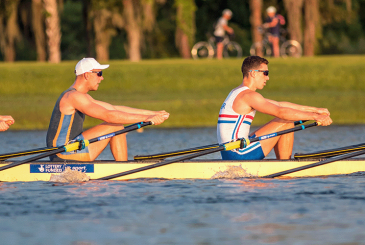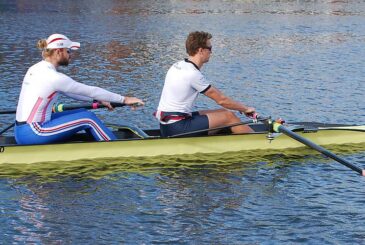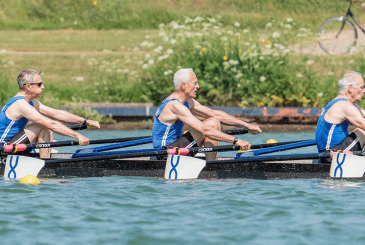Rosie Mayglothling explores the pathway of the blade and she shares tips for masters on boat movement
We looked at the stroke cycle in depth in my first article on technique. Now we’ll focus on the pathway of the blade. Coach consultant Robin Williams speaks about the push and pull requirement of the rowing stroke in Advanced Rowing. The boat is moving at the lowest speed and at the start of the stroke and the load is heavy, which explains why we use the legs to start the stroke. Once the boat speed picks up, then the body and arms can contribute to the handle acceleration by pulling. The boat is moving at its slowest just after the blade goes in at the catch, and when you look from above, the tip of the blade moves initially in the same direction as the boat is travelling and then out from the boat.
Later in the stroke, the blade moves a short distance towards the stern then back in towards the boat. In my early days of rowing, a long stroke in front of the pin was referred to as pinching the boat and being too long at the catch was seen as a waste of effort, but this is not the case anymore. We understand that the blade operates in different ways during the stroke.
From the catch, as already described, the blade has a component of movement in the same direction as the boat and then goes out from the boat. The blade is acting as a “wing” in this early phase, and the boat is lifted forward. Once this initial movement forwards and out finishes, the blade is then acting as a lever. There may also be a release of energy from the shaft of the blade at the finish of the stroke.
The link here from Concept2 gives you pictures and animations to understand this better.
“Being ready to bury the blade at the catch, and build the load early in the stroke, are key to good boat speed”
The force curve
The force curve generated during the stroke is one of the data representations on many rowing machines. Several different systems are available to measure biomechanics on the boat.
The ideal force curve rises reasonably quickly and then maintains the force for as long as possible. It is easier to generate a high force initially as the boat is moving more slowly, but as the hull accelerates, so the force goes down. To continue generating the force through the stroke, the handle must accelerate from the catch to the finish. The larger the area under the curve the more force is generated to move the boat. Variations are given in this example on how quickly the force increases and how long the rower maintains the force.

What does this feel like?
Being ready to bury the blade at the catch, and build the load early in the stroke, are key to good boat speed. Once the blade is in the water, then you need to be patient as you build the load. This is about hanging as much weight on the blade handle as you can and maintaining this through to the finish of the stroke. Remember you are not ripping the blade through the water, but moving the boat past the blade. You should keep the pressure on the foot stretcher after the initial loading and while accelerating the handle from catch to finish. The weight must be maintained on the handle to the finish of the stroke. Feel as light on the seat as possible, which should mean that your weight is moving the boat. As the blade changes direction at the finish, the weight should come back onto the heels and then onto the feet.
The spine
First things first – make sure you can locate your lumbar spine.
Put your hands on your waist with thumbs facing forward and fingers fanned out pointing towards the floor. Now slide your hands around to your back at the same height and where your fingers meet is roughly where your lumbar spine is. It is low down in your back just above the pelvis. This is a part of your back that should move forward with your pelvis during the rock-over and during the drive. This part of your spine is very vulnerable if you try to bend it and then load it up.
“The most efficient way to transfer your power to the rowing stroke is also the safest for your lower back”
From the late 1990s, a project was instigated by Martin McElroy with a former rower, Professor Robert Schroder. Professors Anthony Bull and Alison McGregor led the research with a focus on rowing kinematics and mechanisms of injury. The question was very simple, or so it seemed: to measure the stresses on the lower back during the rowing stroke and work out what produced the most efficient rowing stroke.
The project continued until 2016 and undoubtedly had an impact on the success of the GBR rowers during this period. The research showed conclusively that the most efficient way to transfer your power to the rowing stroke is also the safest for your lower back. Even quite small bends in the lumbar spine at the catch, or slumping at the finish, took power away from the drive.
A recent systematic review published in the BMJ by Nugent et al, (2021) has confirmed this, based on 22 studies and much research in this area.
If we define the perfect stroke, then we can refer to Robin Williams’s sequence of articles on technique, many of which have been published on British Rowing Plus – search for ‘Robin Williams’ above to read them or click here.
You may have heard the term ‘kinetic chain’ in relation to rowing technique. This refers to the groups of body segments, connecting joints, and muscles working together to perform movements and the portion of the spine to which they connect.
The upper kinetic chain consists of the fingers, wrists, forearms, elbows, upper arms, shoulders, shoulder blades, and spinal column. The lower kinetic chain includes the toes, feet, ankles, lower legs, knees, upper legs, hips, pelvis, and spine.
Each joint is independently capable of a variety of movements in both chains, which act together in rowing, and enable the force from the feet, legs and hips to be transferred up the body to the shoulders, arms and hands to create the force on the blade.
So what? Masters’ rowers and technique
Rowing technique and the principles of moving a boat effectively are the same no matter what your age or gender. As you age, your flexibility and strength decline, but you can still achieve good technique by striving to do the following:
- Do all you can to maintain flexibility.
- Core exercises can help enable the kinetic chain to work and maximise the transfer of power. Include resisted side-bends as many rowers are very weak in this plane: these are essential in a cross wind or rocking boat.
- Undertake resistance training ideally twice a week. Weight training, body-weight exercises, resistance bands or TRX type systems are all effective. Include rotation for sweep and sculling.
- Set the boat up to enable you to get in the right positions in the boat. Ensure you have length in front of the pin. About 60% of your stroke length should be in front of the pin.
- Take video and analyse your technique.
- Feel the boat move. Shut your eyes and focus on the feel and sounds of the boat.
- Synchronise your movements.
Rhythm is important and has not been mentioned yet. The ratio up the slide and in the water is important. Robin Williams writes in Advanced Rowing that at rate 20, the drive takes 0.9 seconds, the recovery 2.1 seconds. In sprint racing, this may be 0.7 seconds drive to 0.8 recovery. The drive time is similar but the recovery significantly less, so the skill of changing direction at either side of the drive is really important and has to be developed.
Tips for masters
If you struggle with flexibility, especially in the ankles, then try making the foot stretcher a little flatter, maybe 40 rather than the standard 42 degrees to the horizontal. Alternatively, you can lower your feet. You can also try using a seat pad, but this marginally changes the centre of gravity and may require the height of the swivel to go up. All three can have consequences with the body collapsing over the knees at the catch rather than the knees coming up to the body. Maintain the good body posture to maintain the horizontal drive rather than driving up.
We all get slower with aging, and this must be managed.
As you get slower:
- Reduce the length of the blade or reduce the size of the spoon. Look up the rigging charts for boats of your speed rather than just sticking to the same rig. This should help you maintain the ratio of drive to recovery. Practise at race-rate to know if your rig is right. This needs to be over a significant distance near to, or equal to, the race distance. A rig that is too heavy may be good for 800m, but not the final 200m.
- Reduce the span, but at the same time reduce the overall length of the blade and make sure the inboard and overlap are appropriate. If you do not do this, you will be severely restricted by the amount of overlap you have, which will reduce your stroke length.
- Use the rig to make sure you can have the length in front of the pin, so the blade can work efficiently as described above.

Sabine Damer, pictured above at stroke, and Inge Schwerzmann at bow are Masters C/D rowers. Sabine started rowing at 24 years old. Until about eight years ago, Sabine had not been coached, but had learnt to row by watching and feeling. Inge is a multiple medallist for Germany from U19 to Seniors and was a world champion in 1990 and Olympic silver medallist in 1992. They row together, mainly in a pair from Rapperswil in Zurich, Switzerland.
Unless you are an avatar, your technique will not be perfect but despite the technical differences, it will enable the boat to run. In the training videos of Sabine and Inge above and below, look at the stern which keeps moving. The blades go in at the catch position and they build the load. They do not struggle or fight each other for balance. They use the recovery to keep the boat moving.
Sabine and Inge’s synchronisation is very good. Look at the timing of the seat movements. Both are very critical of their technique when they see pictures or video sequences of it but their feel is very good, and they work with each other.
Together, we have discussed their technique and boat-moving, but it is about bringing them together and smoothing out differences rather than breaking down the technique and probably building a slower boat.
Inge is working on the readiness to go in the water at the catch and coming around the rigger and Sabine to hold on to the finish a little longer. Inge has very long legs and so it is difficult in the pair for her to get her shins completely vertical.
Look at what works well in your boat and develop this. This also needs to be appropriate for the boat size. A faster moving boat such as an eight requires everyone to be ready for the catch in good time and to load the blade a little more quickly.
Take it further
Check out these books and resources below:
1 – Rowing and Sculling by (2015) Rosie Mayglothling with Tristan Mayglothling. Available here from Crowood Press.
2 – Robin Williams has written several articles on rowing technique on British Rowing Plus.
3 – The Biomechanics of Rowing (2020) revised 2nd edition by Dr Valery Kleshnev. Available here from Crowood Press.
4 – Advanced Rowing: International Perspectives on High Performance Rowing Edited by Charles Simpson and Jim Flood (2017), published by Bloomsbury and available here.










